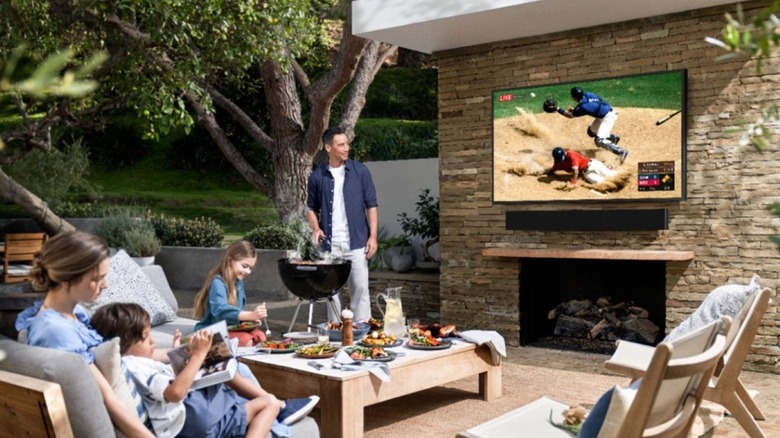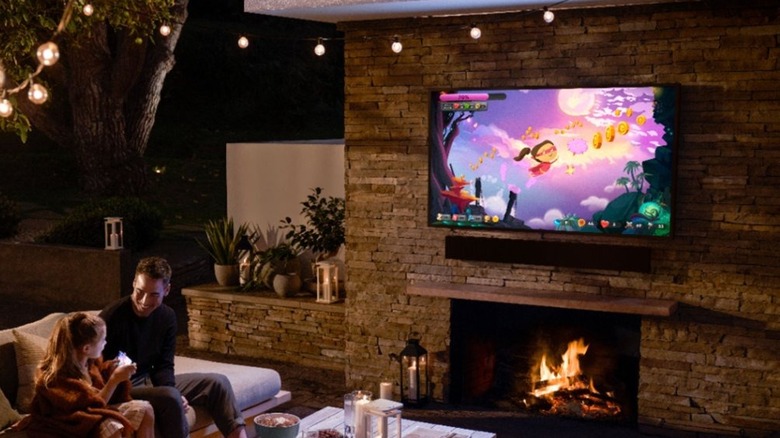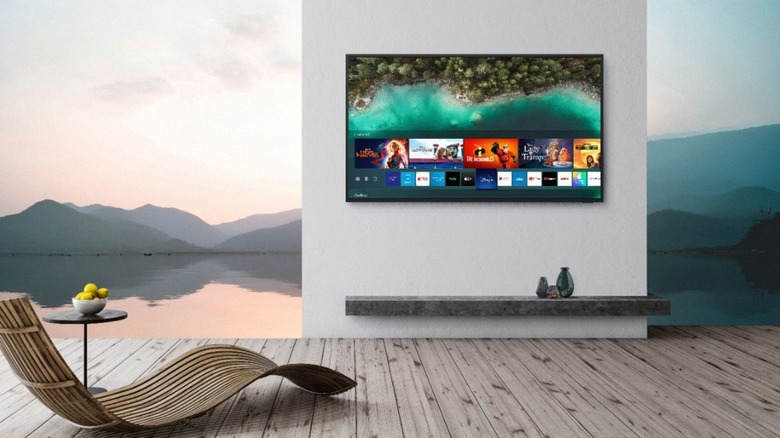Why Are Outdoor TVs So Expensive (And Are They Worth It)?
Although some serial outdoorsy types have enjoyed backyard movie nights for decades, the activity's popularity exploded at the height of the pandemic. Between closed movie theaters and social distancing fears, homebound gatherings in the relative safety of the outdoors just made sense. Some people already had outdoor projector setups ready to go, and if their home's exterior featured large white paneling, they didn't even need to pull out the screen.
But one underrated option many caught onto was outdoor TVs. This product serves the exact purpose you'd think based on the name: It's a TV meant for outdoor use. You can mount them to the side of your house just as you would in your living room, and they can play all the same content as any ordinary TV.
It sounds great, but most prospective buyers get choked up at checkout. Outdoor TVs are significantly most expensive than their regular counterparts, and it's hard to understand why if you have little knowledge of what goes into making them. We're here to quell your curiosity and help you decide whether it's worth snapping one of these up for the patio.
Outdoor TVs vs Indoor TVs: What's the difference?
It's important to understand what differs between an outdoor TV and a regular one. Manufacturers mass-produce ordinary TVs with inexpensive panels and parts, and they use tried and true assembly processes to get them out of the door.
But outdoor TVs are different. They require special considerations, such as weatherproofed casings. The innards will have more gaskets and other premium sealing components to keep moisture and dust at bay.
The panels also have to be specially made to combat sunlight glare. The visibility of most standard TVs suffers in brightly lit indoor rooms, so outdoor panels have to go above and beyond in this area to provide the best picture possible. Because of this, they are often more expensive.
Outdoor TVs also need the ability to withstand extreme temperature changes, so they require better ventilation and cooling to counteract the summer heat. Add in the rugged parts and chassis needed to survive the elements and protect parts from rain-induced rust or golf ball-sized hail, and you have a recipe for an inflated bill of materials.
And because it's such a niche market overall, manufacturers charge a premium for these TVs to compensate for the added production costs and lack of sales volume. That's just the way it is for stuff like this.
Are outdoor TVs worth it?
Well, that depends on what "worth it" means for you. Do you like watching TV outdoors? If you're watching content outside most weekends, then sure, it might be worth it. But your budget will be the biggest determining factor.
You can find an older 55-inch outdoor TV from Sylvox for just $1,599 at Amazon, but the brand is relatively unproven. SunBrite is one of the most notable manufacturers specializing in outdoor TVs, but this older 55-inch model costs roughly $168 more. Prefer something from a reputable brand like Samsung? Expect to pay upwards of $3,000 for its top-notch Terrace series.
But you can get a similar experience using an outdoor projector, which you can find for hundreds or thousands less. For comparison's sake, this 1080p outdoor projector costs just $59.47. Something more substantial, like Anker's 1080p NEBULA laser projector, costs $899.99. However, those projectors don't perform as well in direct sunlight, so you'll also want to consider the time of day you're most likely to enjoy outdoor viewing.
And if you end up needing a TV outdoors for a one-off viewing party with friends, you might be able to get away with setting up your regular TV outside. We'd avoid this if possible, as your warranty is unlikely to cover anything that goes wrong. Mind the weather conditions when and if you decide to do that, though, and you shouldn't have any issues.


